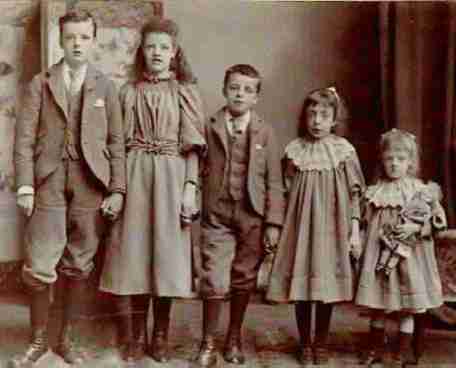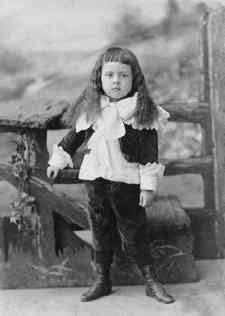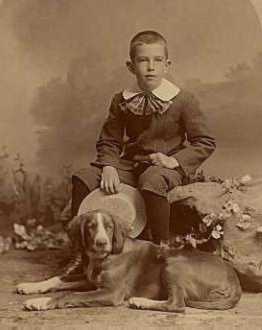
Figure 12.--These brothers in the 1890s wear identical knicker suits. Note that knickers were not worn with cuffs.


Figure 12.--These brothers in the 1890s wear identical knicker suits. Note that knickers were not worn with cuffs. |
Trousers have been made in a variety of materials. The most traditional
is flannel, but there are many other materials,
The term flannel originated in the Welsh
gwlanen meaning woollen article, is a loosely woven and dully
finished weave which shot to popularity with the comfortably-cut trousers of the 1920s. Soft and easy-going, yet elegantly tailored,
grey flannels were originally intended for the summer, ideally suited
to be worn with the blazer. By the late 1930s,
most men were wearing flannel trousers throughout the year, including as
part of suits. They also became the primary material used for boys' short
trousers in England.
One sporty material for trousers is Bedford cord.
This is a twill woven with a lengthwise rib.
Another sporty material is calvary twill which
has a 63 degree diagonal rib. It produces a strong and resiliant cloth
that is often worn when riding. Colors are commonly rust and moss. They
can be "beaded," meaning the seams are raised--giving a casual appearance.
Beaded trousers, however, should only be worn with blazers or sports jackets,
never with a suit.
Velvet is one of the most familiar of what are known as pile fabrics. It is produced by adding to the usual warp and weft threads of plain weaving and additional row of warp yarns which are woven into the ground

Figure 3.--The classic Fauntleroy was made with velvet kneepants, but suits in many other fabrics were also availale. -- |
Real velvet is made entirely of silk, but a kind is made with a silk
face on a cotton basis. Velvet is believed to have been first made in
China. Modern velvets are also made of synthetic fibers, such as
rayon.
Velvet trousers were primarily made for boys. They were mostly
kneepants for Little Lord Fauntlroy suits. Fancy velvet suits had
appeared before the Fauntleroy craze which began in the mid-1880s.
The Fauntleroy suit continued to be popular until World War I.
Velveteen is a plush form of cotton corduroy. It was not commonly
used for trousers, but a style of velveteen shorts were popular in
England during the 1970s and early 80s. They were briefly cut shorts
with elastic eaistbands and no pockets or flies.
The most popular cotton trousers are known by the American
term chinos, Spanish for Chinese. These cotton trousers were
originally produced in Manchester, England and exported to China. The Chinese
do not seem to have been to impressed with them and proceeded to sell them
to Americans soldiers assigned to the Philippine Islands during the 1920s
and 30s. Spanish was still
widely spoken in the Phillipines, thus the Spanish term for Chinese. These
comfortable, light weight trousers are widely worn in the summer. American
boys cmmonly wore them to school in the 1950s and 60s before jeans were
permitted. Preppy wear team a blue blazer with chinos and some boys
wore their blazer with short pants chinos.
Cassimere was mostly used to produce trousers as part of suits.
Cheviot was originally a fine wollen fabric made from the wool of the cheviot
sheep named after the Cheviot Hills in Scotland. Modern cheviot wollens
are usually made from the fine, soft wool of Australian or British sheep
which have been crossbreadwith cheviot or merino sheep. It is woven in
some variation of the twill weave, often with herringbone or diamond
patterns, is rough and heavy, and is similar to tweeds. Worsted
cheviots may be almost any type od soft, strong worsted; they are generally
woven in variations of the twill weave, and are similar to serges except
that they have slightly more nap. Cheap cheviots often have a mixture of
cotton. A heavy, twilled cotton fabric used for shitings, which often has
a fancy pattern woven in with a dobby loom, is also called cheviot.
Cheviot was a popular material for boys suits in the 19th century.
Cheviot trousers were usually made as part of a suit and commonly available
as kneepant.
Searsucker was the clasic material
of the 1920s for summer suits. It was popular in the years before easy to care for
synthetic materials. American boys also wore searsucker short pants, both
as informal dress summer shorts and as play shorts.

Figure 4.--This Vermont boy in the 1890s wears a Norfolk suit with kneepants and long stockings. Note the wide white collar and large bow, not commonly worn wit Norfolk suits. |
Serge was a relatively inexpensive, but hard wearing
material. As such it was commonly used for military unifors or boys'
clothes such as blue winter sailor suits.
Corduroy has a royal lineage,
the term in French, corde du roi, literally meaning the King's cloth.
It was the livery of the king's hunting servants. It eventually became
accepted as a low-cost substitute for velvet. It was in the 19th Century
only considered suitable for the working class, but eventually grew in
popularity for country wear. American boys in the 1920s and 30s commonly
wore knickers which were quite acceptable school
wear. British boys wore cord shorts, I think begiining in the 1920s through
the 50s, but some schools adopted them for
school umiforms. Cord shorts were also commonly worn in France, both
for school wear (many Catholic colleges required blue cord shorts) and for
Scouts. Cord shots even appeared in America in the 1980s, as short cut
OPs.
Syntheic fibers appeared after World War II
(1939-45). By the 1950s Terelyne worsted blends had begun to replace
flannel trousers in England. The change included boys' short trousers.
Some conservative schools continued to insist on flannel, but mothers
liked the easy care Terelyne. It held a crease without ironing and
could be washed rather than dry cleaned.
Blue jeans, a central symbol of modern American culture, were in fact the creation of a 19th
century German immigrant, Levi Strauss. He was born during 1829 in Buttenheim, Bavaria.
Teenage Levi Strauss, his two sisters and his mother sailed for America in 1847, where they
join half-brothers Jonas and Louis in New York. Levi joined the dry goods business of his
older brothers. Levi in 1853 becomes an American citizen. He sailed to San Francisco to take
advantage of the gold rush boom. Strauss and his brother set up their small dry goods store
near the waterfront, where they could easily get shipments from the Strauss brothers back from
the east. The store grows into a prosperous business by the 1870s.
Levi Strauss discovered rugged pants for miners made out of sturdy brown canvas. Once this
resource was exhausted, he turned to denim, which he dyed blue to become what is known
now as blue jeans.